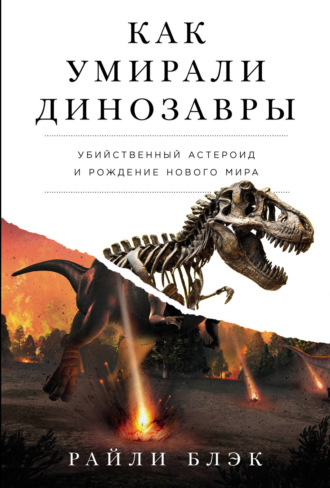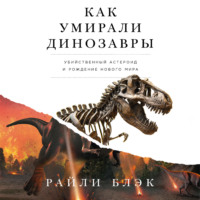
Полная версия
Как умирали динозавры: Убийственный астероид и рождение нового мира
7
D. Jablonski and W. Chaloner. 1994. Extinctions in the fossil record (and discussion). Philosophical Transactions of the Royal Society of London B 344 (1307): 11–17.
8
R. Irmis, S. Nesbitt, K. Padian, et al. 2007. A Late Triassic dinosauromorph assemblage from New Mexico and the rise of dinosaurs. Science 317 (5836): 358–61.
9
P. Wilson, G. Wilson Mantilla, and C. Stromberg. 2021. Seafood salad: A diverse latest Cretaceous florule from eastern Montana. Cretaceous Research 121 (5981): 104734.
10
J. Scannella, D. Fowler, M. Goodwin, and J. Horner. 2014. Evolutionary trends in Triceratops from the Hell Creek Formation, Montana. PNAS 111 (28): 10245–50.
11
N. Arens and S. Allen. 2014. A florule from the base of the Hell Creek Formation in the type area of eastern Montana: Implications for vegetation and climate, in Through the End of the Cretaceous in the Type Locality of the Hell Creek Formation in Montana and Adjacent Areas, eds. G. Wilson Mantilla, W. Clemens, J. Horner, and J. Hartman. (Washington, DC: Geological Society of America).
12
A. Balanoff, G. Bever, T. Rowe, and M. Norell. 2013. Evolutionary origins of the avian brain. Nature 501: 93–96.
13
M. Witton and M. Habib. 2010. On the size and flight diversity of giant pterosaurs, the use of birds as pterosaur analogues and comments on pterosaur flightlessness. PLOS ONE 5 (11): e13982.
14
T. Ikejiri, Y. Lu, and B. Zhang. 2020. Two-step extinction of Late Cretaceous marine vertebrates in northern Gulf of Mexico prolonged biodiversity loss prior to the Chicxulub impact. Scientific Reports 10: 4169; T. Tyrrell, A. Merico, and D. McKay. 2015. Severity of ocean acidification following the end-Cretaceous asteroid impact. PNAS 112 (21): 6556–61.
15
D. Grossnickle and E. Newham. 2016. Therian mammals experience an ecomorphological radiation during the Late Cretaceous and selective extinction at the K-Pg boundary. Proceedings of the Royal Society B 283: 20160256; N. Longrich, B. Bhullar, and J. Gauthier. 2012. Mass extinction of lizards and snakes at the Cretaceous-Paleogene boundary. PNAS 109 (52): 21396–21401.
16
D. Robertson, W. Lewis, P. Sheehan, and O. Toon. 2013. K-Pg extinction patterns in marine and freshwater environments: The impact winter model. Journal of Geophysical Research: Biogeosciences 118 (3): 1006–14.
17
A. Chamberlin, S. Chesley, P. Chodas, et al. 2001. Sentry: An automated close approach monitoring system for near-Earth objects. Bulletin of the American Astronomical Society 33: 1116.
18
D. Jablonksi. 2001. Lessons from the past: Evolutionary impacts of mass extinctions. PNAS 98 (10): 5393–98.
19
P. Sheehan. 2001. The Late Ordovician mass extinction. Annual Review of Earth and Planetary Sciences 29: 331–64.
20
M. Caplan and R. Buston. 1999. Devonian Carboniferous Hangenberg mass extinction event, widespread organic-rich mudrock and anoxia: Causes and consequences. Palaeogeography, Palaeoclimatology, Palaeoecology 148 (4): 187–207.
21
U. Brand, R. Posenato, R. Came, et al. 2012. The end-Permian mass extinction: A rapid volcanic CO2 and CH4-climatic catastrophe. Chemical Geology 322–323: 121–44.
22
J. Davies, A. Marzoli, H. Bertrand, et al. 2017. End-Triassic mass extinction started by intrusive CAMP activity. Nature Communications 8: 15596.
23
A. Chiarenza, P. Mannion, D. Lunt, et al. 2019. Ecological niche modelling does not support climatically-driven dinosaur diversity decline before the Cretaceous/Paleogene mass extinction. Nature Communications 10: 1091.
24
D. Naish and D. Martill. 2007. Dinosaurs of Great Britain and the role of the Geological Society of London in their discovery: Basal Dinosauria and Saurischia. Journal of the Geological Society 164: 493–510.
25
B. Switek. 2013. My Beloved Brontosaurus (New York: FSG), 190–200.
26
M. Benton. 1990. Scientific methodologies in collision: The history of the study of the extinction of the dinosaurs. Evolutionary Biology 24: 371–400.
27
N. MacLeod. 1998. Impacts and marine invertebrate extinctions. Geological Society, London, Special Publications 140: 217–46.
28
L. Alvarez, W. Alvarez, F. Asaro, and H. Michel. 1980. Extraterrestrial cause for the Cretaceous-Tertiary extinction. Science 208 (4448): 1095–108.
29
A. Hildebrand, G. Penfield, D. Kring, et al. 1991. Chicxulub crater: A possible Cretaceous/ Tertiary boundary impact crater on the Yucatán Peninsula, Mexico. Geology 19 (9): 867–71.
30
R. Worth, S. Sigurdsson, and C. House. 2013. Seeding life on the moons of the outer planets via lithopanspermia. Astrobiology 13 (12): 1155–65.
31
R. Tagle and P. Claeys. 2005. An ordinary chondrite impactor for the Popigai crater, Siberia. Geochimica et Cosmochimica Acta 69 (11): 2877–89.
32
S. Ekhtiari, K. Chiba, S. Popovic, et al. 2020. First case of osteosarcoma in a dinosaur: A multimodal diagnosis. The Lancet 21 (8): 1021–1022.
33
W. Sellers, P. Manning, T. Lyson, et al. 2009. Virtual palaeontology: Gait reconstruction of extinct vertebrates using high performance computing. Palaeontologia Electronica 12 (3): 1–26.
34
D. Hone and and O. Rauhut. 2010. Feeding behaviour and bone utilization by theropod dinosaurs. Lethaia 43 (2): 232–44.
35
E. Wolff, S. Salisbury, J. Horner, and D. Varricchio. 2009. Common avian infection plagued the tyrant dinosaurs. PLOS ONE 4 (9): e7288.
36
S. Brusatte, M. Norell, T. Carr, et al. 2010. Tyrannosaur paleobiology: New research on ancient exemplar organisms. Science 329 (5998): 1481–85.
37
C. Kammerer, S. Nesbitt, J. Flynn, et al. 2020. A tiny ornithodiran archosaur from the Triassic of Madagascar and the role of miniaturization in dinosaur and pterosaur ancestry. PNAS 117 (30): 17932–36.
38
T. Blackburn, P. Olsen, S. Bowring, et al. 2013. Zircon U-Pb geochronology links the end-Triassic extinction with the Central Atlantic Magmatic Province. Science 340 (6135): 941–45.




